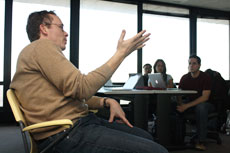Fermilab hosts CMS data analysis school
 |
|
Martijn Mulders, a CMS physicist, facilitates classes during hands-on exercises. Photo: Brad Hooker
|
With the 2012 run for the Large Hadron Collider two months away, a new wave of scientists will be ready to analyze the flood of data from CMS.
From Jan. 10 through Jan. 14, Fermilab hosted the CMS Data Analysis School, an intensive workshop that gives the newest members of the collaboration a crash course on the experiment. Previously known as the "EJTERM" workshop, Fermilab's LHC Physics Center co-coordinators, Rick Cavanaugh and Ian Shipsey, decided to rename the school to emphasize its primary focus: the hands-on analysis of real data and the opportunity to search for new physics.
"We put these students in a competitive environment and they love it," Shipsey said on the day before the students presented their work. "Many won't sleep tonight in order to finish things up and get good results for tomorrow."
The school teaches students how to spot a small detail in the big picture, much like how scientists look for new physics, Shipsey said.
Professors looking to polish analysis techniques worked alongside graduate students eager to apply their two months of preparatory work to the intensive collaborative exercises. Without the accelerated preparation and school, it would take an attendee as many as two years to gain this level of experience. The overwhelming success of this school has led to a new program in Italy later this month and another being planned for Asia.
"The sun never sets on CMS," said Sudhir Malik, a Fermilab physicist chairing the workshop. "Students have a fun time and learn as well. And word is being spread."
Venkatesh Veeraraghavan, a graduate student at Florida State University, was one of 127 attendees who participated in exercises at the school. He appreciated the opportunity to get comfortable with the actual software tools used in CMS analysis.
"It was a good introduction to the basics required for any large analysis of this experiment," he said.
More than 60 CMS senior scientists and software experts taught all of the classes, giving graduate students like Brendan Diamond, also at FSU, the opportunity to meet key people on the collaboration.
"We can get a lot more done with the personal interactions rather than the lectures," he said. "We're getting a jumpstart on our own analysis, rather than slogging through textbooks and wikis to understand this."
—Brad Hooker
|